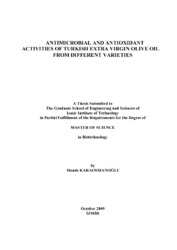Please use this identifier to cite or link to this item:
https://hdl.handle.net/11147/3027Full metadata record
| DC Field | Value | Language |
|---|---|---|
| dc.contributor.advisor | Soyer Dönmez, Ferda | en |
| dc.contributor.author | Karaosmanoğlu, Hande | - |
| dc.date.accessioned | 2014-07-22T13:50:44Z | - |
| dc.date.available | 2014-07-22T13:50:44Z | - |
| dc.date.issued | 2009 | en |
| dc.identifier.uri | http://hdl.handle.net/11147/3027 | - |
| dc.description | Thesis (Master)--Izmir Institute of Technology, Biotechnology, Izmir, 2009 | en |
| dc.description | Includes bibliographical references (leaves: 58-64) | en |
| dc.description | Text in English; Abstract: Turkish and English | en |
| dc.description | xiii, 79 leaves | en |
| dc.description.abstract | Olive oil is the main source of fat in Mediterranean diet. The major active components of olive oil include oleic acid, phenolic compounds and squalene which have different benefits such as cancer prevention, antimicrobial and antioxidant activities, and lowering the incidence of skin cancer, respectively. In recent years, the number of studies about the biochemical properties of different varieties of olive oils and their phenolic contents has dramatically increased.In this study, Turkish EVOO from different varieties and their phenolic compounds were investigated in terms of their antimicrobial and antioxidant properties as well as refined olive, hazelnut and canola oils. Antimicrobial activities of EVOOs and ten phenolic compounds were tested against three foodborne pathogenic bacteria, Escherichia coli O157:H7, Listeria monocytogenes and Salmonella Enteritidis which are the foremost bacterial cause of the largest number of outbreaks, cases and deaths in the world. While all EVOOs showed bactericidal effect the phenolics demonstrated slight antimicrobial activity with percent inhibition between 0-25 of growth rate of bacteria. Moreover, refined olive, hazelnut and canola oils did not show any antimicrobial activity.Finally, antioxidant activities of EVOOs, refined olive, hazelnut and canola oils were determined by B-carotene-linoleic acid model system and ABTS radical scavenging method. According to B-carotene-linoleic acid method, it was observed that antioxidant activities of oil samples varied between 21.19% and 64.54%. On the other hand, it was found that free radical scavenging activities varied between 1.21% and 21.97% as a result of ABTS method. These results were correlated with TPC values of oils. | en |
| dc.language.iso | en | en_US |
| dc.publisher | Izmir Institute of Technology | en |
| dc.rights | info:eu-repo/semantics/openAccess | en_US |
| dc.subject.lcc | QP752.O42 .K18 2009 | en |
| dc.subject.lcsh | Olive oil | en |
| dc.subject.lcsh | Olive oil--Therapeutic use | en |
| dc.subject.lcsh | Phenols--Therapeutic use | en |
| dc.title | Antimicrobial and antioxidant activities of Turkish extra virgin olive oil from different varieties | en_US |
| dc.type | Master Thesis | en_US |
| dc.institutionauthor | Karaosmanoğlu, Hande | - |
| dc.department | Thesis (Master)--İzmir Institute of Technology, Bioengineering | en_US |
| dc.relation.publicationcategory | Tez | en_US |
| item.fulltext | With Fulltext | - |
| item.grantfulltext | open | - |
| item.languageiso639-1 | en | - |
| item.openairecristype | http://purl.org/coar/resource_type/c_18cf | - |
| item.cerifentitytype | Publications | - |
| item.openairetype | Master Thesis | - |
| Appears in Collections: | Master Degree / Yüksek Lisans Tezleri | |
Files in This Item:
| File | Description | Size | Format | |
|---|---|---|---|---|
| T000177.pdf | MasterThesis | 4.45 MB | Adobe PDF |  View/Open |
CORE Recommender
Page view(s)
204
checked on Nov 18, 2024
Download(s)
106
checked on Nov 18, 2024
Google ScholarTM
Check
Items in GCRIS Repository are protected by copyright, with all rights reserved, unless otherwise indicated.